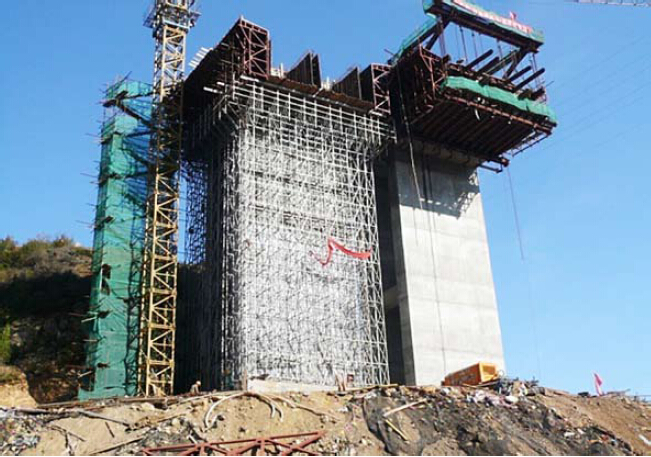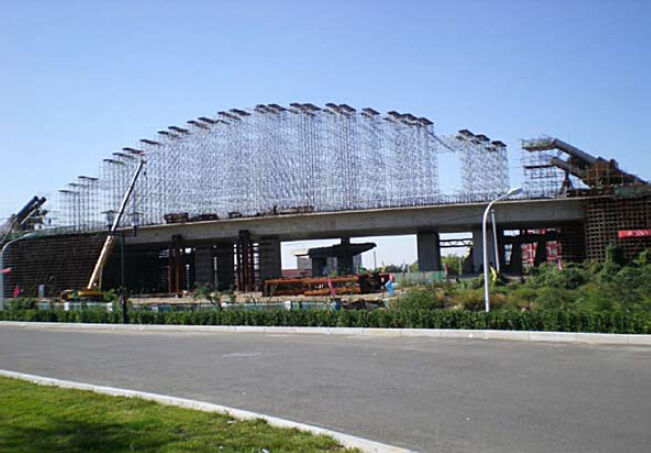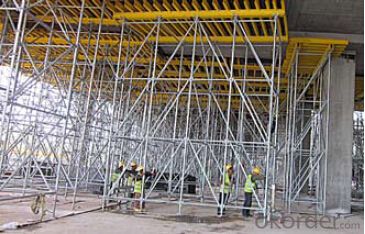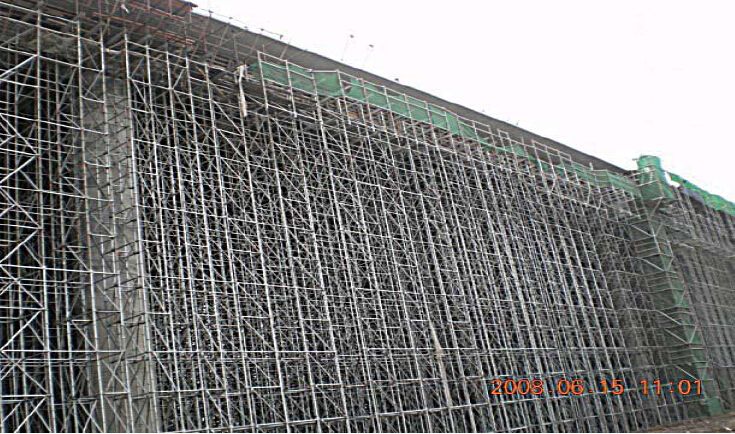Tower scaffolding for formwork and scaffolding systems
- Loading Port:
- Tianjin
- Payment Terms:
- TT OR LC
- Min Order Qty:
- 50 m²
- Supply Capability:
- 1000 m²/month
OKorder Service Pledge
Quality Product, Order Online Tracking, Timely Delivery
OKorder Financial Service
Credit Rating, Credit Services, Credit Purchasing
You Might Also Like
Tower Scaffolding
Shoring tower is an effective supporting system. It is easy to assemble and dismantlement, and
has excellent stability and bearing capacity. It has been widely used in the construction of industry
& residential buildings , bridges, tunnels and dam project, etc.
Characteristics:
◆ High degree of standardization.
◆ Easy storage and transportation


- Q: Can steel formwork be used for dam construction?
- Indeed, dam construction can make effective use of steel formwork. This adaptable and long-lasting alternative is widely employed in a range of construction endeavors, including dams. It boasts various benefits, such as exceptional strength, stiffness, and the capacity to endure the immense pressure and weight of concrete utilized in dam construction. The assembly and disassembly of steel formwork are straightforward, enabling efficient and rapid construction. Moreover, it yields a sleek and consistent surface to the concrete, guaranteeing the durability and longevity of the dam's structure.
- Q: Can steel formwork be used for underground tunnels?
- Yes, steel formwork can be used for underground tunnels. Steel formwork is a versatile and durable material that is commonly used in construction projects, including underground tunnels. It is able to withstand the pressure and forces exerted by the surrounding soil and rock, making it suitable for use in the construction of tunnels. Additionally, steel formwork is easy to assemble and disassemble, allowing for efficient construction and maintenance of tunnels. Its strength and durability make it a popular choice for underground tunnel construction, providing a reliable and long-lasting solution.
- Q: Can steel formwork be used in educational or institutional construction projects?
- Yes, steel formwork can be used in educational or institutional construction projects. Steel formwork is commonly used in various construction projects, including those in the educational and institutional sectors. It provides a durable and versatile solution for casting concrete structures, ensuring the strength and stability required for these types of projects. Additionally, steel formwork allows for efficient construction processes, reducing the overall project duration and costs.
- Q: How does steel formwork handle concrete flowability and workability?
- Steel formwork is highly effective in handling concrete flowability and workability due to its durable and rigid nature. When concrete is poured into steel formwork, it easily conforms to the desired shape, resulting in a smooth and even finish. The steel formwork provides excellent support and stability, preventing any deformation or movement during the pouring and curing process. Steel formwork is designed to withstand the pressure exerted by the concrete, ensuring that it can handle any flowability variations. The formwork's tight joints and smooth surfaces allow for better control of the concrete's flow, preventing any leakage or seepage. This enables the concrete to be placed precisely and evenly, ensuring a consistent quality throughout the structure. Moreover, steel formwork is highly adaptable, allowing for easy adjustments and modifications to accommodate changes in concrete flowability and workability. The formwork can be easily assembled, disassembled, and repositioned as needed, providing flexibility in construction projects. Additionally, steel formwork offers a high level of reusability. Its durability and resistance to wear and tear make it suitable for multiple concrete placements, reducing overall construction costs and environmental impact. In summary, steel formwork effectively handles concrete flowability and workability by providing a stable and rigid structure that supports the concrete during placement and curing. Its adaptability, durability, and reusability make it a preferred choice in construction projects where precise and consistent concrete finishing is desired.
- Q: Are there any specific design considerations for steel formwork?
- Yes, there are specific design considerations for steel formwork. These include factors such as the strength and stability of the steel structure, the weight-bearing capacity of the formwork, ease of assembly and disassembly, compatibility with different concrete mixtures, and the ability to withstand various site conditions such as weather and construction loads. Additionally, the design should also consider the reusability and durability of the steel formwork system to ensure cost-effectiveness and sustainability in construction projects.
- Q: What are the common design considerations for steel formwork in cold climates?
- Several factors need to be taken into account when designing steel formwork in cold climates to ensure its structural integrity, safety, and efficiency. These considerations are crucial in extreme weather conditions. 1. The selection of the appropriate steel grade is crucial to withstand low temperatures without compromising strength. It is essential to choose high-quality steel with good cold resistance properties to prevent brittleness and potential failure. 2. Insulation materials should be incorporated into the design to minimize heat loss during concrete curing. Insulating the formwork walls and base can prevent freezing, which may cause cracking and reduced structural integrity. 3. Steel contracts in cold temperatures, leading to misalignment and buckling of the formwork. To accommodate thermal expansion and contraction, it is important to include expansion joints or flexible connections in the formwork design. 4. Proper anchoring and support systems need to be incorporated into the formwork design to ensure stability and prevent shifting or settling, especially in cold climates with freeze-thaw cycles that cause significant ground movement. 5. Cold and humid environments can accelerate corrosion of steel. Enhancing durability and prolonging the lifespan of the steel formwork can be achieved by incorporating corrosion-resistant coatings or galvanizing. 6. The formwork design should take into consideration the additional loads imposed by accumulated snow in cold climates with heavy snowfall. This is necessary to prevent overloading and potential collapse of the structure. 7. Cold temperatures can affect the performance of fastening systems, such as bolts and screws. It is crucial to use appropriate fasteners that can withstand low temperatures and prevent loosening due to thermal contraction. 8. Considering the ease of assembly and dismantling of the formwork is important in cold climates where extreme temperatures may hinder construction activities. Designing the formwork system with easy-to-use connections and fasteners can improve efficiency and reduce construction time. By taking these common design considerations into account, engineers and designers can ensure that steel formwork in cold climates is safe, reliable, and capable of withstanding the harsh conditions.
- Q: Is steel formwork suitable for projects with high wind loads?
- Yes, steel formwork is suitable for projects with high wind loads. Steel formwork is known for its strength, durability, and stability, making it an ideal choice for construction projects that are subject to high wind loads. Steel formwork provides excellent resistance against wind forces and can withstand strong winds without deformation or damage. Additionally, steel formwork offers a high level of dimensional accuracy, ensuring that the structure can withstand the forces exerted by the wind without compromising its stability. Therefore, steel formwork is a reliable and suitable option for projects with high wind loads.
- Q: How does steel formwork affect the overall speed of construction?
- The numerous advantages of steel formwork greatly contribute to the overall speed of construction. Firstly, its high durability ensures that it can withstand the pressure of concrete pouring without any deformation or damage. This durability allows for multiple reuses of the formwork, eliminating the need for constant replacement with new materials and saving both time and cost. Furthermore, steel formwork provides a smooth and even surface finish, which reduces the time needed for additional plastering or finishing work. This smooth finish also guarantees accurate alignment of structural elements, resulting in faster and more efficient construction. In addition, the ease of assembly and disassembly of steel formwork facilitates quick installation and removal. This user-friendly feature eliminates the need for extensive labor and minimizes the time required for formwork setup, ultimately accelerating the construction process. Moreover, steel formwork is highly adaptable and can be used in various types of building structures. Its flexibility allows for customization and efficient utilization in different construction projects, further enhancing the overall speed of construction. In conclusion, the utilization of steel formwork has a positive impact on the speed of construction by offering durability, a smooth finish, ease of assembly and disassembly, and adaptability. These advantages result in time and cost savings, efficient construction processes, and ultimately faster project completion.
- Q: What are the common design considerations for steel formwork in earthquake-prone areas?
- In earthquake-prone areas, the design considerations for steel formwork are crucial to ensure the safety and stability of structures during seismic events. Some common design considerations for steel formwork in earthquake-prone areas include: 1. Material Strength: The steel used in formwork should have high tensile strength to withstand the lateral forces generated during an earthquake. High-strength steel, such as Grade 60 or Grade 80, is commonly used in earthquake-resistant formwork designs. 2. Reinforcement: The formwork should be adequately reinforced to enhance its rigidity and resistance to seismic forces. Additional reinforcement can be provided by adding steel braces, cross-bracing, or diagonal members to increase the structural integrity of the formwork system. 3. Connection Details: The connection details between different formwork elements should be designed to withstand the dynamic forces induced by earthquakes. Welded or bolted connections are commonly used, ensuring that they have adequate strength and ductility to resist seismic loads. 4. Stiffness and Flexibility: The formwork system should exhibit an appropriate balance between stiffness and flexibility. It should be rigid enough to resist lateral forces during an earthquake but also flexible enough to absorb and dissipate seismic energy without collapsing. 5. Anchorage Systems: Anchorage systems are crucial in securing the formwork to the foundation or supporting structure. These systems should be designed to resist the uplift and lateral forces generated during an earthquake and prevent the formwork from overturning or sliding. 6. Diaphragm Action: To enhance the overall structural performance, the formwork system should be designed to provide diaphragm action. This means that the formwork acts as a continuous and rigid panel transferring forces across its surface, thereby reducing localized stresses and improving the overall stability of the structure during an earthquake. 7. Formwork Compatibility: The steel formwork should be compatible with other structural elements, such as concrete columns, beams, and slabs. It is essential to ensure that the formwork system can adequately transfer the loads from the concrete to the supporting structure without compromising its stability or integrity during seismic events. 8. Construction Practices: In addition to design considerations, proper construction practices play a vital role in ensuring the effectiveness of steel formwork in earthquake-prone areas. Adequate bracing and temporary supports should be used during formwork assembly to maintain stability and prevent collapse before the concrete is poured and hardened. By considering these design considerations, engineers and designers can develop robust steel formwork systems that can withstand the forces exerted by earthquakes and ensure the safety of structures in seismic regions.
- Q: How does steel formwork compare to timber formwork?
- Construction projects often prefer steel formwork over timber formwork for several reasons. Firstly, steel formwork is highly durable and long-lasting compared to timber formwork. Steel is a resilient material that can withstand heavy loads and harsh weather, making it ideal for multiple uses and reducing the need for frequent replacements. In terms of strength, steel formwork provides greater structural integrity and stability. It can handle higher concrete pressures, allowing for the construction of taller and more complex structures. This is particularly advantageous for high-rise buildings or projects that require large spans. Steel formwork also offers superior dimensional accuracy and consistency. Unlike timber, it does not warp or distort over time, ensuring that the final concrete structure maintains its intended shape and dimensions. This saves time and effort during construction, as fewer adjustments or corrections are necessary. Moreover, steel formwork is easier to clean and maintain. It does not absorb moisture or attract pests like timber does, reducing the risk of deterioration or contamination. Additionally, steel formwork can be easily reused multiple times, making it a more sustainable and cost-effective option in the long run. However, it is important to note that steel formwork generally requires more specialized equipment and skilled labor for assembly and disassembly compared to timber formwork. This may result in higher initial costs and longer setup times for projects. Furthermore, steel formwork may not be suitable for certain applications where weight is a concern, as it is generally heavier than timber. Overall, while both steel and timber formwork have their pros and cons, steel formwork is often preferred in construction due to its durability, strength, dimensional accuracy, and ease of maintenance.
Send your message to us
Tower scaffolding for formwork and scaffolding systems
- Loading Port:
- Tianjin
- Payment Terms:
- TT OR LC
- Min Order Qty:
- 50 m²
- Supply Capability:
- 1000 m²/month
OKorder Service Pledge
Quality Product, Order Online Tracking, Timely Delivery
OKorder Financial Service
Credit Rating, Credit Services, Credit Purchasing
Similar products
Hot products
Hot Searches
Related keywords


















